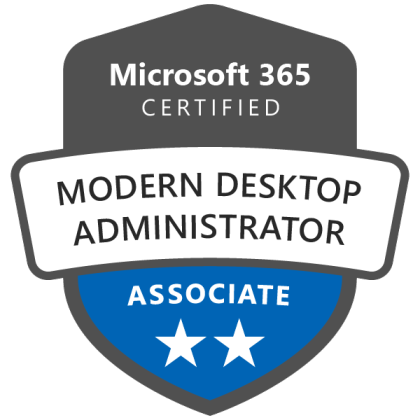MD-100: Windows Client
Welcome to MD-100: Windows Client course! In this course, students will learn the tasks needed to install, configure, protect, and maintain Windows 10 and later client desktops. The tasks and information covered are designed for IT professionals supporting clients and devices within an organization. The course helps prepare for exam MD-100. This course the first of two courses supporting the Microsoft 365 Certified: Modern Desktop Administrator Associate certification. It is recommended that students complete this course prior to taking course MD-101 - Managing Modern Desktops. Windows is continuously updated with new features and capabilities, and offers new methods of deployment, management, and integration with today's cloud technologies. Windows 11 is the newest client operating system, released in October 2021. Windows 11 is built on the same foundation as Windows 10 and is a natural transition and update to those already familiar with Windows 10. While Windows 11 represents a significant change to the user experience, the technologies and processes needed to manage Windows 10 also apply to Windows 11. While this course uses Windows 10 in many examples, it has been updated to cover the differences introduced in Windows 11. The skills learned in this course will generally apply to both versions, unless otherwise specified.Throughout the course MD-100: Windows Client, you will be provided with the opportunity of completing a series of hands-on labs that will test your ability to perform tasks in the software.
Microsoft Courseware
Instructor-Led Training
Course Duration: 5-Days (40-Hour)
Microsoft Official Lab Exercises
Courseware Life Time Free Upgrade
Cloud Lab Access
Overview
In this course, students will learn the tasks needed to install, configure, protect, and maintain Windows 10 and later client desktops. The tasks and information covered are designed for IT professionals supporting clients and devices within an organization.
Given the dynamic nature of Microsoft cloud tools, you may experience user interface (UI) changes that were made following the development of this training content. This will manifest itself in UI changes that do not match up with the detailed instructions presented in this lab manual. The Microsoft World-Wide Learning team will update this training course as soon as any such changes are brought to our attention. However, given the dynamic nature of cloud updates, you may run into UI changes before this training content is updated. If this occurs, you will have to adapt to the changes and work through them in the lab exercises as needed.
Modules
Module 1: Install the Windows client
- Explore the Windows client
- Explore the Windows client editions and requirements
- Evaluate Windows client installation methods
- Upgrade and migrate Windows clients
- Evaluate deployment methods
Module 2: Configure authorization and authentication
- Explore authentication
- Manage users and groups
- Configure user account control
- Implement device registration
Module 3: Configure post-installation settings and personalization
- Explore common configuration options
- Explore advanced configuration methods
- Manage drivers and device peripherals
Module 4: Configure networking on Windows clients
- Configure IP network connectivity
- Explore name resolution
- Configure wireless network connectivity
- Explore remote access
- Employ remote management
Module 5: Configure storage on Windows clients
- Manage storage on Windows clients
- Maintain disks and volumes
- Implement Storage Spaces
Module 6: Configure data access and usage
- Explore Windows client file systems
- Configure and manage file access
- Configure and manage shared folders
- Manage user files
Module 7: Manage apps and Windows updates
- Provide apps to users
- Manage the Microsoft Edge browser
- Explore the Windows servicing model
- Update Windows clients
Module 8: Configure threat protection
- Explore malware and threat protection
- Explore Microsoft Defender
- Explore device encryption features
- Explore connection security rules
- Explore advanced protection methods
Module 9: Support the Windows client Environment
- Explore troubleshooting methodologies
- Explore Windows architecture
- Explore support and diagnostic tools
- Monitor and troubleshoot Windows client performance
Module 10: Troubleshoot the Windows client operating system and apps
- Employ file recovery in Windows client
- Explore application troubleshooting
- Troubleshoot Windows startup
- Troubleshoot operating system service issues
Module 11: Troubleshoot hardware and drivers
- Troubleshoot device driver failures
- Explore physical hardware troubleshooting
- Troubleshoot physical failures on Windows clients
Fees And Schedule
Instructor-Led Training
40-Hour of Instructor-Led Training One to one doubt resolution sessions Microsoft Official Lab AccessLearning Objectives
After completing this course, you'll learn how to:
- Install, personalize, and update Windows 10 and later
- Configure networking and storage
- Install and manage applications
- Configure authentication and permissions
- Protect the OS and data
- Support and troubleshoot common issues
Reviews

Dipak Agarwal - Business Analyst at Genpact
Excellent professional & comfortable environment to learn
The training was good, I would like to go through some more training.

Gurpreet Marwaha - IAM Analyst at National Australia Bank, Australia
I learned a lot
Excellent Office 365 training provided by Flexmind
Kiranmai Yachareni - Web Developer at Total Quality Logistics, USA
Excellent ability to clarify all the queries I raised
Thank You! I would definitely recommend it to others. The training session was very informative and interactive. Very useful and definitely thought-provoking. All the module sessions were clear and interactive, great, and friendly. Catered to all levels, which was good for those just starting out and those with more experience. I really appreciate the recorded videos and training material, which would be definitely helpful for later references.

Praveen S (Associate at Grant Thornton LLP)
Excellent knowledge of the trainer on the Subject
I attended PowerApps/Flow training from Flexmind. The topics of the course were well organized & knowledge of the trainer on the subject was excellent. It was very helpful and I will apply in my day to day task at the office. I will definitely recommend a friend or colleague to attend courses from Flexmind.
